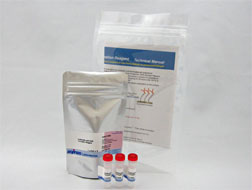10-Carboxy-1-decanethiol

Self Assembled Monolayer Reagent
-
Product codeC385 10-Carboxy-1-decanethiol
-
CAS No.71310-21-9
-
Chemical name10-Carboxy-1-decanethiol
-
MWC11H22O2S=218.36
| Unit size | Price | Item Code |
|---|---|---|
| 10 mg | Find your distributors | C385-10 |
| 100 mg | Find your distributors | C385-12 |
Description
Structural Formula

Product Description
Carboxyalkanethiols are utilized for the modification of a gold surface to introduce carboxylic groups on it. The carboxylic group is often converted to activated N-hydroxysuccinimide ester, which reacts with an amine group of biomaterials. Dojindo’s newly developed 15-Carboxy-1-pentadecanethiol has a 15-carbon chain, which is the longest alkanethiol available in the market among carboxyalkanethiols. Five different carboxyalkanethiols including Carboxy-EG6-undecanethiol are available for gold surface modification. Malone and others fabricated a highly sensitive SPR sensor using 15-Carboxy-1-pentadecanethiol. Glenn and coworkers used carboxyalkanethiol and poly-L-lysine to create an immobilized cytochrome b5 multilayer electrode. Mizutani and others fabricated immobilized glucose oxidase multilayer electrodes in a similar manner. Both groups reported electron transfer from biomaterials to a gold surface. These kinds of multilayer film electrodes are well suited for studies of diffusion electron transfer. Frisbie and others developed a new method, chemical force microscopy, for obtaining the adhesive interactions and the friction image of patterned sample surfaces. They used atomic force microscopy (AFM) to measure the interactions and spatial mapping of chemically distinct functional groups. Frisbie and others formed carboxyalkanethiol monolayers on the gold surfaces of AFM cantilever tips. They used AFM to measure the adhesive and friction forces between molecularly modified probe tips and organic monolayers terminating in a lithographically defined pattern of distinct functional groups.
References
1) M. R. Malone, J-F. Masson, S. Beaudoin, K. S. Booksh, Proceedings of SPIE-The International Society for Optical Engineering, 2005, 6007.
2) F. Mizutani, Y. Sato, S. Yabuki and Y. Hirata, Enzyme Ultra-thin Layer Electrode Prepared by the Co-adsorption of Poly-L-lysine and Glucose Oxidase onto a Mercaptopropionic Acid-Modified Gold Surface, Chem. Lett., 1996, 251.
3) C. D. Frisbie, F. Rozsnyai, A. Noy, M. S. Wrighton and C. M. Lieber, Functional Group Imaging by Chemical Force Microscopy, Science, 1994, 265,2071.
4) M. Kyo, K. Usui-Aoki and H. Koga, Label-free Detection of Proteins in Crude Cell Lysate with Antibody Arrays by a Surface Plasmon Resonance Imaging Technique, Anal. Chem., 2005, 77, 7115.
Handling and storage condition
| Appearance: | White to slightly yellow powder |
|---|---|
| Purity (HPLC): | ≧ 97.0 % |
| NMR spectrum: | Authentic |
| 0-5°C, Nitrogen substitution |










